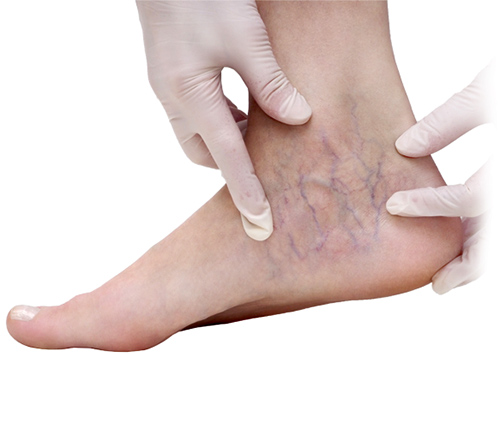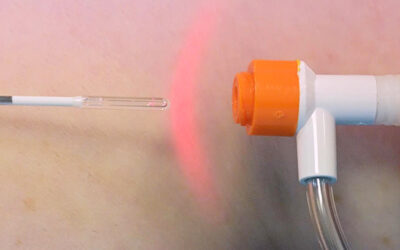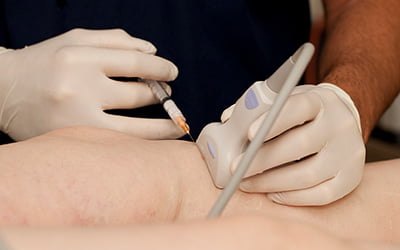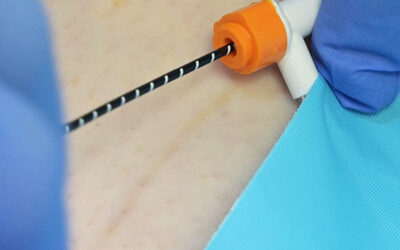Varicose Veins in Feet and Ankles
Spider veins or varicose veins that appear around the ankle or foot are known as Corona Phlebectasia by medical professionals. Etymologically, ‘corona’ refers to fan-like rays that radiate from the sun’s surface and, in this medical context, describes the fan-shaped nature of spider vein capillaries on the inside of the foot. ‘Phlebectasia’ indicates the presence of abnormal veins and capillaries. Together these terms refer to a fan-like spread of abnormal capillaries.

What causes ankle and foot varicose veins?
When working as they should, veins transport blood in a single direction back to the lungs and heart in order to be oxygenated. Sometimes, the valves within the vein walls that keep blood flowing in one direction fail, causing blood to leak backward. This phenomenon is known as venous reflux or venous insufficiency. When blood pools in a part of the vein suffering from venous reflux, a bulge may appear on the surface of the skin.
Patients that suffer from prominent ankle veins or Corona Phlebectasia almost always have underlying venous insufficiency around the small saphenous veins or the perforator veins in the lower leg. This can be treated using a laser or radiofrequency treatment known as endovenous ablation or a medical adhesive procedure called cyanoacrylate closure.
Doctors should always investigate the possibility that a patient with prominent ankle veins has issues with venous insufficiency. Ankle and foot veins should not be treated in isolation, rather, a duplex ultrasound examination should be conducted to identify underlying vein issues.
Do ankle and foot varicosities need to be treated?
Patients with suspected venous insufficiency should see a phlebologist with expertise in the discovery and treatment of the condition. Even small blue veins around the ankles and feet can indicate an emerging vein condition.
If untreated for too long, varicose veins can cause a number of problematic symptoms including venous eczema, skin discolouration, leg swelling, ulceration, and a hardening of the ankle and lower leg. They can also cause serious blood clots.
Common symptoms of varicose veins in your feet and ankles
- Aching in legs, ankle and feet.
- Throbbing, itching and burning around the legs, ankle and feet.
- Restless legs and frequent cramping
- Leg heaviness and fatigue
- Foot or ankle vein is swollen, red, or tender to touch
- Skin ulceration or rash near your ankle (indicates severe veinous disease)
- Breaks in skin around the foot/ankle vein
People with venous disease or problem veins in their feet and ankle region, may present in three main ways
- Prominent veins alone – visibly large and bulging varicose veins, smaller thread-like spider veins or reticular veins, without other symptoms or pain.
- Prominent veins plus symptoms like swelling in the leg, or venous ulcers (breakdown in skin around the lower leg or ankle region)
- Symptoms alone with no visible abnormal veins
How We Treat Ankle and Foot Varicose Veins
Endovenous Laser Ablation (EVLA)
Under ultrasound guidance, a laser fibre is placed into the abnormal vein through a tiny incision. When the laser is activated and the fibre is slowly removed, this produces a reaction in the vein wall along the treated section, resulting in collapse and sclerosis of the vein wall with minimal discomfort.
Ultrasound Guided Sclerotherapy
Ultrasound Guided Sclerotherapy is a highly specialised procedure involving injecting a sclerosant solution into the abnormal veins using ultrasound guidance, causing the vein wall to collapse. The veins dissolve and disappear as the body gradually absorbs them.
Radiofrequency Ablation
Radiofrequency ablation (RFA) relies on thermal (heat based) damage to the vein, that leads to immediate closure of the vein. Once the vein is treated by radiofrequency ablation, it will gradually undergo complete absorption by the body and disappear over time.

Your vein surgeon will choose the treatment that perfectly suits your veins.
Medicare Rebate & Costs
The cost of treating varicose veins depends on severity of the veins as well as which treatment is used. We discuss these costs in detail at your initial consultation.
A Medicare rebate is claimable on all varicose vein procedures, except the most superficial spider veins.

What to expect
Learn all about your first appointment, what's included, and how much it will cost.



